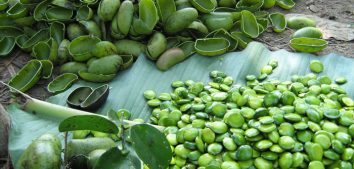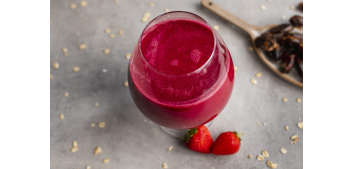
Matcha – What You Need to Know about It
Matcha tea has been gaining in popularity recently. It is available in virtually all cafés 🙂 No wonder! Matcha has numerous health-promoting properties, which is why I decided to delve into the topic and share the insights with you.
What Is Matcha?
Matcha is a traditional Japanese tea. It comes in the form of a powder that is made from dried and ground green tea leaves. The powder has a beautiful, intense green color. It differs from green tea in that about three weeks before harvesting, the leaves are shaded to protect them from the sun’s rays. Thanks to this, the growth process slows down and more chlorophyll, antioxidants and micronutrients are produced in the leaves. Matcha is prepared from whole leaves of green tea, which is why it retains more health-promoting substances than regular tea.
The history of matcha in Japan dates back to the 13th century, when Buddhist monks noticed it helped them to stay focused during long hours of meditation. However, outside Asia, it only became popular in the 21st century. Lots of studies have been conducted in recent years, which indicate the positive aspects of drinking this type of tea. It’s all thanks to the very high content of two polyphenols: L-theanine and EGCG catechins.
A Strong Antioxidant
Matcha has a strong antioxidant effect thanks to the EGCG catechins I mentioned before. The antioxidants contained in tea leaves neutralize the negative effects of free radicals that attack healthy molecules, contributing to the development of cardiovascular, skin and eye diseases. Free radicals are “swept out”, and the body achieves a balance between the content of pro-oxidant and antioxidant compounds, eliminating oxidative stress that damages cells. In terms of antioxidant content, one cup of matcha is equivalent to as many as 10 cups of ordinary green tea infusion!
It Has Anti-Cancer Properties
Thanks to their antioxidant properties, EGCG catechins also inhibit the formation of cancer cells by suppressing enzymes that stimulate their growth and activity. One study noted that supplementing with 600 mg of catechins contained in green tea reduced the development of prostate cancer. The anticancer effect of catechins has also been shown in association with colorectal and oral cancer.
It Strengthens the Immune System
The catechins contained in matcha also have antibacterial, antiviral and antifungal properties which strengthen the immune system. In addition, just one cup of this tea is a good source of vitamins A and C, potassium, calcium, iron, and zinc, which helps to replenish deficiencies in the body and also supports the immune system.
It Facilitates Weight Loss
Matcha tea is recommended for people who want to lose weight. It was noticed that drinking matcha speeds up the fat burning process up to four times. In addition, EGCG catechins “turn up” metabolism, which helps you deal with excess fat tissue faster. and regulate metabolism.
It Reduces Stress and Relaxes
Another valuable matcha ingredient is L-theanine, an organic compound which is a non-protein amino acid found primarily in green tea leaves, but also in smaller amounts in mushrooms. Theanine is especially recommended for people with the problem of nervous tension and anxiety because it reduces stress levels and improves mood. It has been shown to affect brainwave activity, producing a feeling of relaxation and calm without causing drowsiness.
It Increases Learning Ability and Improves Memory
Theanine has a beneficial effect on maintaining the proper level of serotonin and dopamine in the body which are important for maintaining well-being and creativity. Serotonin and dopamine act as neurotransmitters, transmitting information between nerve cells. Their appropriate level in the body regulates blood pressure, and is responsible for the willingness to act, learn, and explore.
How to Use Matcha?
Now that you have found out about the main benefits of matcha, you are probably wondering how you can use it in practice. The first idea that comes up is to prepare a beverage based on matcha.
To prepare it in the traditional way, you need: chawan – a bowl, chasen – a bamboo tea whisk and chashaku – a wooden spoon, but you can also easily manage without such professional equipment. Just put a teaspoon of tea into a glass and add water (100 ml, maximum 80 ℃). Then mix with a milk frother and top up with water.
Matcha can also be added to baked goods (cookies, banana bread), ice cream (kids will go crazy about the green color :)), smoothies or puddings, e.g. based on chia seeds.
Remember that it is also important to store matcha properly. Keep it away from light, moisture and heat. You can store it in a cupboard with other kinds of tea, but a fridge will also be a good place.
Matcha is also available in the Foods by Ann store HERE.
I strongly encourage you to check it out! 🙂
Bibliography:
- Baba Y, Inagaki S, Nakagawa S, Kobayashi M, Kaneko T, Takihara T. Effects of Daily Matcha and Caffeine Intake on Mild Acute Psychological Stress-Related Cognitive Function in Middle-Aged and Older Adults: A Randomized Placebo-Controlled Study. Nutrients. 2021 May 17;13(5):1700.
- Bettuzzi S, Brausi M, Rizzi F, Castagnetti G, Peracchia G, Corti A. Chemoprevention of human prostate cancer by oral administration of green tea catechins in volunteers with high-grade prostate intraepithelial neoplasia: a preliminary report from a one-year proof-of-principle study. Cancer Res. 2006 Jan 15;66(2):1234-40.
- Kochman J, Jakubczyk K, Antoniewicz J, Mruk H, Janda K. Health Benefits and Chemical Composition of Matcha Green Tea: A Review. Molecules. 2020 Dec 27;26(1):85.
- Mancini E, Beglinger C, Drewe J, Zanchi D, Lang UE, Borgwardt S. Green tea effects on cognition, mood and human brain function: A systematic review. Phytomedicine. 2017 Oct 15;34:26-37.
- Unno K, Furushima D, Hamamoto S, Iguchi K, Yamada H, Morita A, Horie H, Nakamura Y. Stress-Reducing Function of Matcha Green Tea in Animal Experiments and Clinical Trials. Nutrients. 2018 Oct 10;10(10):1468.









Comments No Comments
Join the discussion…